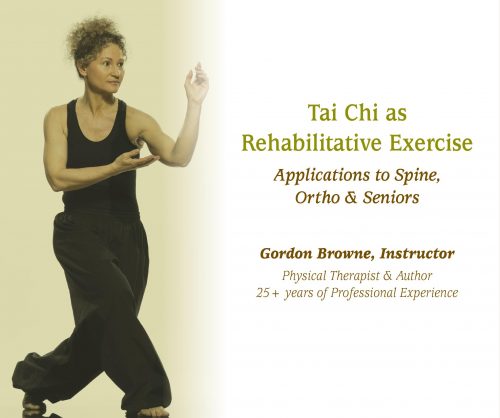Tai Chi as Rehabilitative Exercise
Applications to Spine, Ortho & Seniors
8 Hours/CEUs
Course Description
Tai Chi is more than a martial art or a moving meditation; it is a sophisticated movement system that has great potential for application to a rehab setting. In this fun and interactive course we will begin by breaking down and simplifying tai chi movements into grounding & balancing stances, stepping motions and upper extremity organization. We'll then put it all together in ways that integrate and optimize relationships between the upper and lower body. You'll be actively participating in movement, as well as observing and analyzing tai chi modifications, then discuss clinical relevance and application to a wide variety of rehab-related conditions. Topics include:
- Lumbar stabilization, knee alignment & joint replacements
- Balance improvement, gait facilitation & fall prevention
- Pelvic balancing, thoracic mobilization & cervical stabilization
- Glenohumeral impingement & scapular dyskinesia
- Ortho, neuro & geriatric applications
We will also discuss and demonstrate the importance of Pattern Specificity, making exercise more informational by making it resemble the motor behavior we are trying to influence, and investigate the differences between Static and Dynamic Integrated Movement Principles. Come spend the day with us, we’ll get up out of our chairs and move; you’ll never look at movement and exercise the same!
Course Objectives
At the completion of this course, the participant will be able to:
- Define Global & Differentiated movement relationships and give one example of each relationship for: knee-hip, hip-lumbar, thorax-neck, scapular-humeral, humeral-forearm.
- List the two main differences between Static & Dynamic Integration Principles.
- Define the difference between “grounding & balancing” stances giving two examples of each.
- Demonstrate basic proficiency in three rotational/weight shifting movements & list benefits for: lumbar stabilization, hip/knee replacements, balance and fall prevention.
- Explain the relevance of the phrase “proximal mobility & distal stability” in the lower extremity system and list benefits for foot, ankle or knee conditions.
- Define the terms “high horizon & weight under-side” and list benefits for cervical, gleno-humeral and shoulder girdle health.
- Cite three research articles that advocate tai chi benefits for balance, fall prevention & frailty reduction in seniors.
Course Outline
Lab sessions include experiential movement, partner observations, facilitation techniques, modifications & discussion of clinical relevance.
7:45-8:00-Registration & Snacks
8:00-8:30-Introduction to Integrated Movement Principles
- Exercise Paradigms: Isolate or Integrate?
- Types of Integrated Movement/Exercise: Static & Dynamic
- Principles of Optimal Movement/Posture
8:30-10:00-Lab I: Tai Chi Stances
- Grounding & Balancing Stances: Skeletal Weight Bearing
- Centering the Feet & Aligning the Knees: Balance & Fall Prevention
- Stabilizing the Pelvis & Lengthening the Low Back
10:00-10:15-Morning Break
10:15-12:00-Lab II: Tai Chi Arm Positions & Movements
- Ladies Hands: Minimizing Unnecessary Effort
- Dynamic Scapular Stabilization & Integrating the Arm
- Gleno-Humeral, Elbow, Forearm & Hand Benefits
12:00-1:00-Lunch on Your Own
1:00-3:00-Lab III: Tai Chi Turns & Steps
- Hip Rotation Mobility & Control: THR, FAI & Labrum
- Lumbar Stabilization, Balance & Fall Prevention
- Controlling Knee Valgus, Varus & Rotation: Knee Injuries, Patella & TKR
3:00-3:15-Afternoon Break
3:15-5:10—Lab IV: Putting it Together—Integrating Upper & Lower Body
- Arms & Head Moving as Extension of Dynamic vs Relative to Static Torso
- Appropriate Distribution of Movement & Proportional Use of Synergists
- Training & Balancing Pelvic Force Couples: Associating with Intentional Arms
5:10-5:30— Bonus Material & Wrap Up
- Toys & Tools: Staff, Sword & Straps
- Review & Reinforcement of Course Objectives
- Research, Questions & Answers

Course Schedule:
State Approvals
We submit all our courses for continuing education approval in the state in which it is being held, if required. For more information please visit our State Approvals page
Registration Fee
| Single Registrant | $229 |
| 2 to 4* | $219 |
| 5 or more* | $209 |
*Price per person when registering at the same time. Please call if paying separately.
Brochure
Download the BrochureTestimonials
“Gordon and Julie are the best instructors! I enjoyed everything about this course and highly recommend it.”
“Loved it! Knowledgeable instructors, friendly and passionate about movement.”
“Great presentation! Loved the specifics of the info and great manual.”
“I really learned really good, new material/movements that I can easily integrate with my patients.”
“This content is going to be so useful for balance and gait training with elderly patients. Great discussion and practice of dynamic movement.”
“Great course, appreciate all the material and active movement during labs. Thank you!”
“Excellent course, excellent information!”
“Great class, loved the mobility and balance training options for seniors and home health setting.”
“Thank you, I will use both personally and in practice.”
“Gordon is a great speaker; lots of learning, labs and demo.”
 Gordon Browne, PT
Gordon Browne, PT